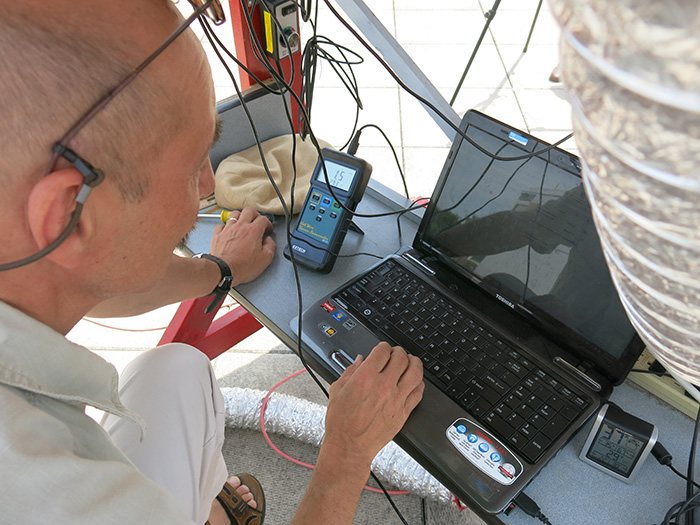More Than Hot Air

Photo by Tony Moore.
Journal publishes article on new solar energy device
by MaryAlice Bitts-Jackson
Solar power is the fastest-growing energy source in the U.S., according to the nation’s Energy Information Administration, and the star of the show is the photovoltaic panel, which generates solar electricity. Still, the majority of U.S. households and businesses do not yet tap this clean, renewable energy source, and the market for solar air heaters (SAH), which generate thermal heat as opposed to electricity, is relatively untapped. What would the world be like if affordable, efficient and easily maintained SAHs were more widely available?
Professor of Physics & Astronomy Hans Pfister asked that question in 2011, and now he and two former students have designed a highly efficient SAH that could be inexpensively and easily constructed and would pay for itself, through energy savings, within about one year of use. A paper describing their new SAH design has been published in the 136th issue of the journal Solar Energy.
Pfister co-wrote the paper with Sung Woo Kim ’13, who majored in physics at Dickinson, and Tyler Ralston ’15, a former double major in mathematics and physics. Kim earned an M.S. in environmental engineering and science from Stanford University in 2015 and is working at a research center in Korea, where he studies how to use sea water to create clean water and clean energy as well as reduce nonrenewable energy output. Ralston is working in project management at an electrical corporation while pursuing a master’s degree in systems engineering from the University of Maryland, College Park.
In their article, they outline a streamlined SAH design, in which air is pushed through the solar air heater via a small fan. The air, while passing through six specially corrugated layers of sunlight-absorbing grids, is heated as it interacts with the hot absorber surface. This SAH can be used to heat a room or small building; several SAHs can be configured as a carbon-footprint-reducing, supplemental system to heat a whole house. It also can be used to efficiently dry and preserve food.
The first prototype was built by former physics technician Rick Lindsey, Pfister, Kim and fellow physics major Andrea "Ilia" Pappas '13; physics technician Johnathan Barrick, Pfister and Ralston built the final prototype, which was mounted atop Tome Hall. Kylie Logan ‘14, Eli Blumenthal ’14 and Ben Kimock ’15 conducted preliminary measurements, while Pfister and Ralston made detailed measurements of the conversion efficiency as a function of the mass flow rate.
Because they were able to eliminate some features typically found in SAHs, their newly designed SAH is cheaper and more easily constructed than peer models. Nevertheless, it boasts a mass flow rate dependent solar-to-thermal energy conversion efficiency of up to 80 percent—one of the highest efficiencies among existing SAHs.
"While the sun is shining, every kWh of energy the solar air heater produces is one kWh of energy that we do not have to obtain by burning a fossil fuel," Pfister wrote in a recent issue of Dickinson Science Magazine. "Therefore, every bit of energy that SAHs provide immediately reduces the amount of CO2 emissions and thus creates a reduction of our carbon footprint."
Learn more
Published August 11, 2016